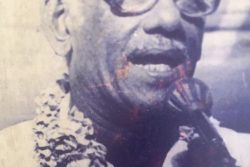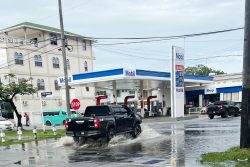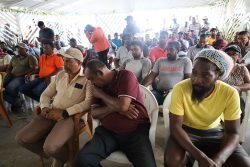Public transportation facilities to the different parts of the Colony are handled by the Government through the Colonial Transport Department and by Messrs. Sprostons, Ltd., as contractors to the Government…The operations of the Colonial Transport Department extend at present along the coastal area from New Amsterdam on the Berbice River, to Suddie and Pomeroon on the Essequibo coast and Bartica on the Essequibo River. Messrs. Sprostons’ services are carried on from Georgetown and New Amsterdam up the rivers towards the interior with one coastal service to Morawhanna in the North West District.
[Transportation services]
The most important of the Ferry services connects up the two banks of the Demerara River from Georgetown on the East Bank to Vreed-en-Hoop on the West Bank. An hourly service is maintained by the S.S. “Queriman,” a steamer recently built in Scotland, splendidly equipped and with ample accommodation for all classes of traffic. First Class Fare, 8 cents; Second Class fare, 4 cents.
New Amsterdam on the Berbice River is connected with the rail head at Rosignol by ferry. First Class fare, 12 cents, Second Class fare, 6 cents. A ferry service three times daily is also maintained on the Essequibo River between Parika and the island of Leguan. First Class fare, 20 cents; Second Class fare, 10 cents. The Government steamers give excellent service on the Essequibo River to Leguan, Wakenaam, Supenaam, Aurora, Adventure and Bartica, the latter being the important station which forms the present gateway to the diamond fields on the Mazaruni. A steamer leaves Georgetown every Monday for Charity, Pomeroon, and this service is extended by launch service to Kabacaburi. The transportation services of a public nature provided by Messrs. Sprostons, Ltd., are as follows:
A coastal steamer service to the North West District of the Colony is maintained weekly between Georgetown and Morawhanna (210 miles) whence the service is continued up the Barima river by launch to Mount Everard (250 miles from Georgetown). The Berbice River is served by a steamer operating twice a week between New Amsterdam and Coomacka (110 miles) and some seventeen intermediate stops are made on the run. Between Wismar and Mallali on the upper Demerara River for a distance of 45 miles, a bi-weekly service is given.
The most interesting and most difficult transportation service and the one that reaches the farthest point is operated by this Company between Georgetown and Potaro landing, Four distinct stages are necessary to complete the journey. The first stage is a comfortable trip by a large and well found steamer for 65 miles up the Demerara River to Wismar. This steamer makes eighteen stops and also serves McKenzie, the works of the Demerara Bauxite Company, Ltd.* on the opposite bank of the river from Wismar. From Wismar the watershed between the Demerara and Essequibo Rivers is crossed by a metre gauge railway 18½ miles in length to Rockstone terminus where a night is spent at the Company’s hotel.
The following morning, the journey is resumed by launch up the Essequibo River and into the Potaro River to Tumatumari, 65 miles from Rockstone. Another night is spent here within sound and sight of the magnificent Tumatumari Falls, around which a portage of one mile is made, the journey being completed by a 12 -mile launch service to Potaro landing in the heart of the gold-bearing district. It is by this route that the famous Kaieteur Fall is reached, an additional two days journey by boat. Arrangements for this trip must be made with Messrs. Sprostons in advance.
[Regulation]
The control of navigation on the principal rivers of the Colony − the Essequibo, Mazaruni, Cuyuni, Demerara (above No. 2 Island), Berbice and Corentyne − and their tributaries is vested in the Commissioner of Lands and Mines as Navigation Officer and the various Wardens, Sub-Wardens and Land Officers of his Department as Deputy Navigation Officers, under the Lower River Boat Regulations, 1912, and the Upper River Boat Regulations, 1912, and their amending Regulations, all enacted under the River Navigation Ordinance of 1891.
The rivers of the North West District are under the control of the District Commissioner as Navigation Officer under the North Western District Boat Regulations, 1912. These Regulations require that all boats and vessels plying on the rivers shall be presented, at least once a year, along with their equipment for inspection by the Navigation Officer or his Deputy or oftener if required to do so by the Officer concerned. If the craft and equipment are found to be in good order, a certificate is issued to that effect; if not, the Officer specifies what defects and deficiencies shall be made good before the craft is again used and if any craft is allowed to proceed on a voyage without complying with this order the owner of the vessel is held to be guilty of a breach of the Regulations and is liable to a penalty of $24.
Vessels propelled by steam or other machinery engaged in carrying passengers have also to be certified as to the number of passengers they are allowed to carry, the maximum being one passenger together with his personal baggage for every five square feet of the deck surface, or, if the vessel has no deck, then for the equivalent area as if a deck existed. This Certificate has to be framed and placed in a conspicuous position on the vessel. Such vessels are required when under way at night to carry a bright white light on or in front of the awning or funnel where it can best be seen at a height above the gunwale of not less than five feet; also a green light on the starboard and a red light on the port side or a combined lantern showing a green light and a red light from the right to two points above the beam on the starboard and port sides respectively, three feet below the white light.
Boats and vessels plying, on the Upper Rivers, i.e., from the first falls upwards, are limited to a maximum length of 40 feet, a maximum width of 7 feet 6 inches and a maximum depth of 2 feet 10 inches, except on such part of the upper rivers as the Officer certifies is not dangerous and which is so specified in the certificate of inspection of such craft. Every vessel or boat other than those propelled by steam or machinery has to be branded by the Officer with a waterline consisting of a straight line of 6 inches long and a one inch wide painted white on a black ground and situated exactly midway between the bow and stern. The freeboard allowed ranges from a minimum of six inches on a boat 24 feet long to 10 inches on a boat 40 feet long. These waterlines must show clearly above water level when the boat is loaded and manned ready for departure.
All boats plying above the first falls have to have certified a steersman and bowman. The steersman stands at the stern of the boat and guides her generally and it is his duty to select the channels to be taken according to the state of the river and the size and load of the boat. The Bowman stand in the bow of the boat armed with long “bow-paddle” when passing through rapids and cataracts and keeps her head up to the current, assists to swing her into position or to fend off rocks and obstructions as the case may be. Both steersman and bowman have to pass a qualifying examination as to their knowledge of the various channels in the different stages of the river, the handling of the boasts through the various cataracts and rapids and their knowledge of river navigation generally. Bowmen have to serve a probationary period as boathands before sitting for examination as bowmen and a further probationary period as bowmen before they can quality as steersmen. The examinations are conducted by the Navigation Officer or his deputies with a “Board” consisting of certificated steersmen of long experience.
[Safety precautions]
No falls or cataracts are allowed to be run between the hours of 6 p.m. and 5.30 a.m. and certain falls are prohibited for running and have to be streaked − a term used for lowering a boat through a fall by its ropes. Each boat plying on the upper rivers has to be equipped with a bow-rope, a stern rope and breast rope of requisite length and strength for the purposes of the voyage and the size of the boat. In addition, a rope not less than eight fathoms in length and one and one-half inches in circumference has to be carried as a life-line, carefully coiled and placed in such a position that it can be readily used for heaving to anyone who falls overboard or is being carried away by the current in hauling his boat up a fall, for which latter purpose the crew has to take to the water.
These precautions have led to a great diminution of accidents in the rapids and cataracts which make navigation hazardous in the upper reaches of the rivers and the average of accidents attended with loss of life is now surprisingly low. As an example, the case of the Mazaruni river − the most dangerous of all the Colony’s waterways − may be quoted, the figures for 1922 giving a total of 955 boats as having left Bartica with an average human freight of about 20 souls and 3 tons of cargo, on the up-journey and an equal human freight on the down journey, without cargo, thus giving approximately 38,200 persons as having travelled on the river during the year out of which the total loss of life by drowning was 16 or .04 per cent.
In addition to the foregoing there are special Regulations termed the River Oil Launches Regulations, 1912, dealing with oil-fuel and motor launches plying on the rivers of the Colony. These deal with the safety measures for storing the petroleum or volatile petroleum or alcohol on board and prohibit smoking in the vicinity of the engines and storage tanks. Every motor vessel is required to have a copy of these Regulations placed in a conspicuous place in the vessel.









